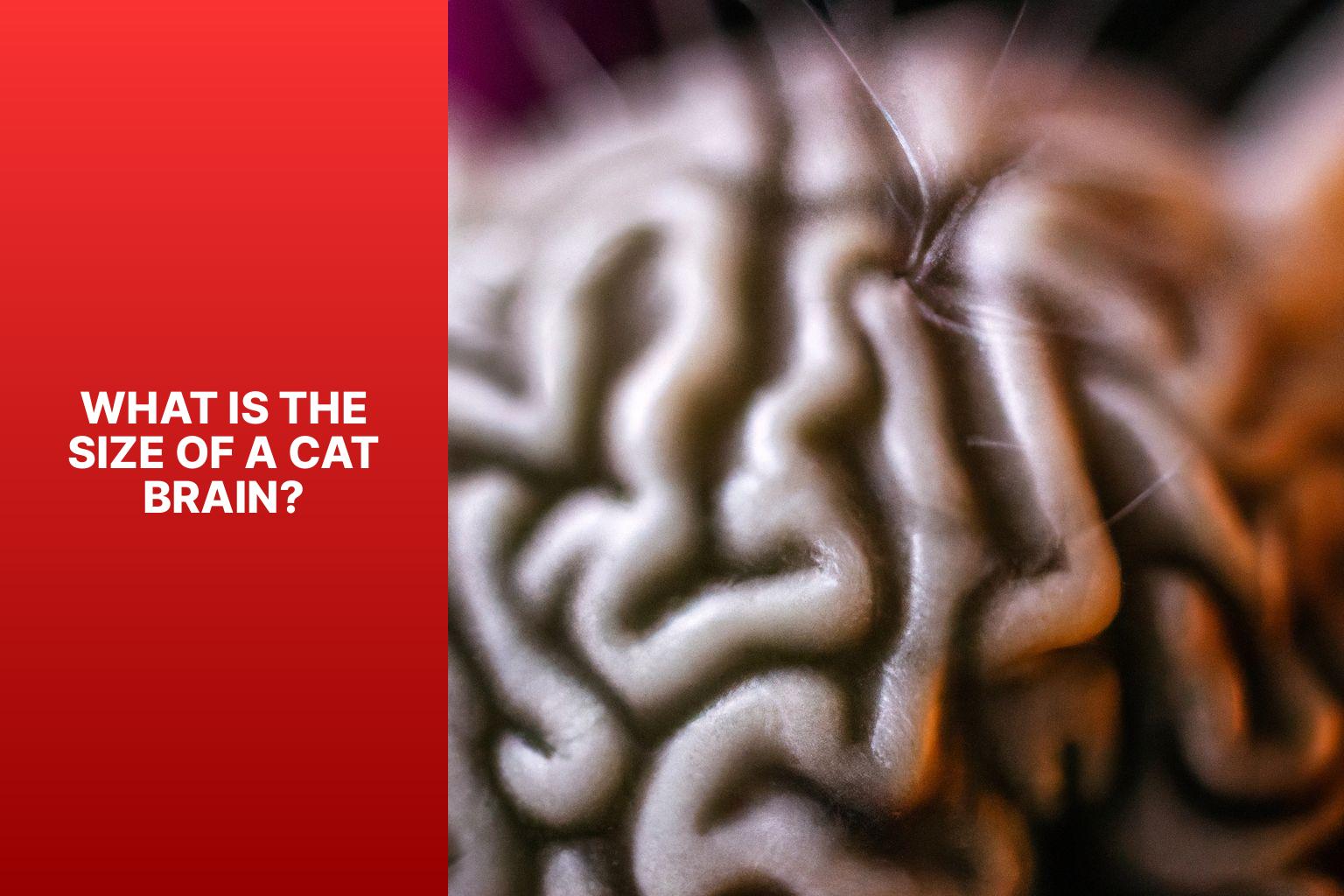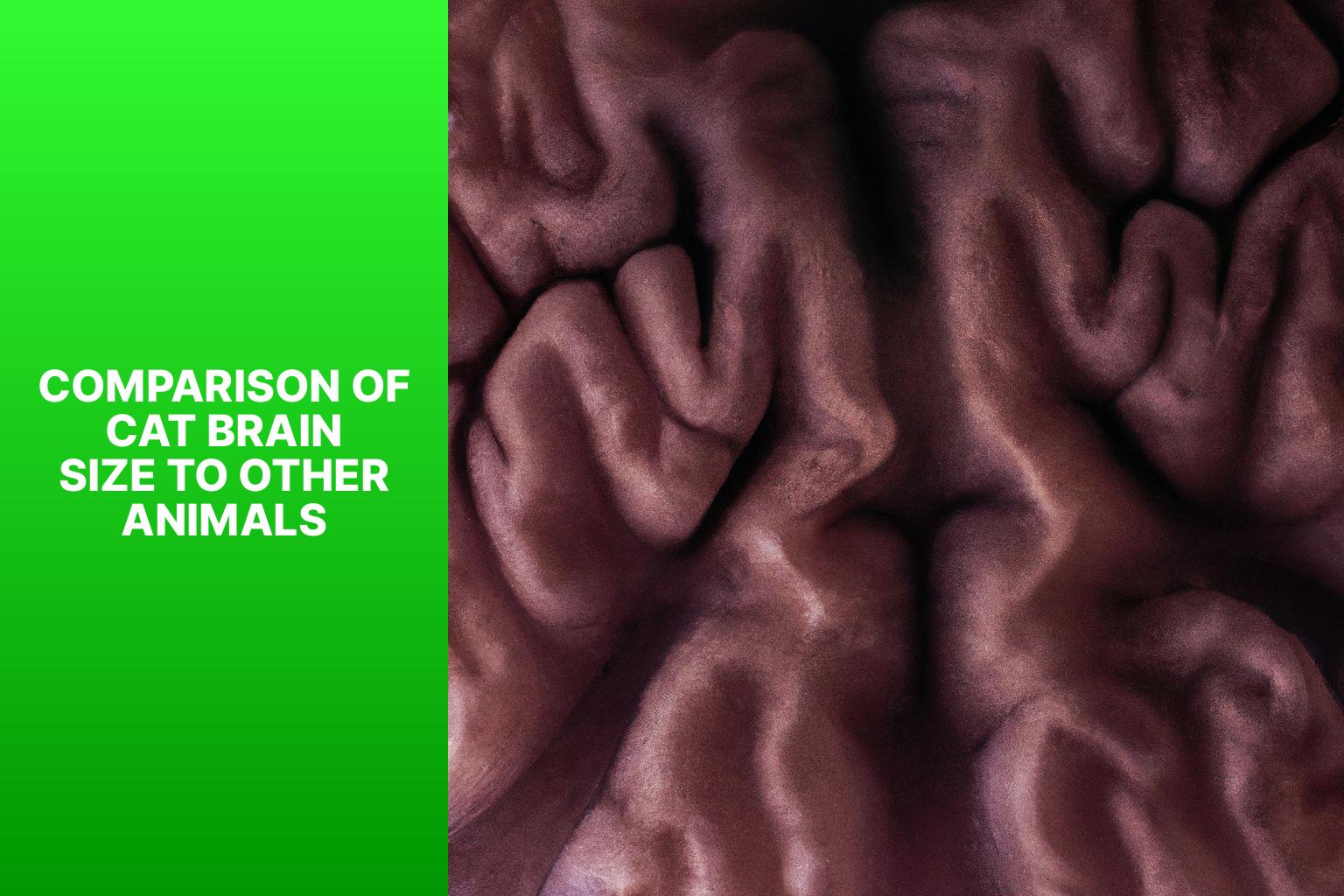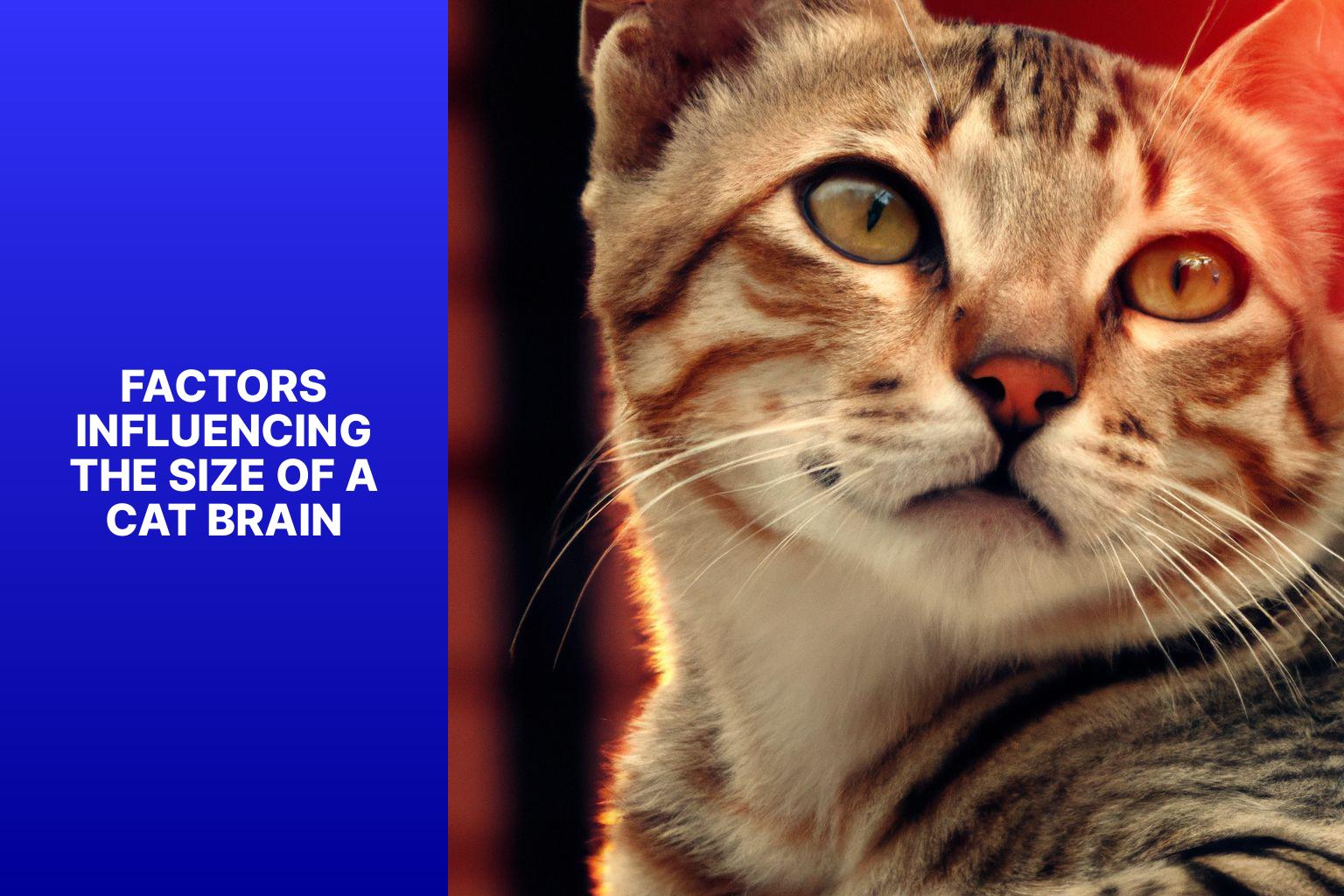The size of a cat’s brain is an intriguing topic, shedding light on the cognitive capabilities and behaviors of our feline friends. While the exact dimensions may vary, a cat’s brain is relatively small compared to other animals. Understanding the size of a cat’s brain involves exploring its comparison to other animals, as well as the functionality and factors influencing its size.
When comparing a cat’s brain to a dog’s brain, there are some noticeable differences. Generally, a cat’s brain is smaller than a dog’s brain, suggesting potential variations in cognitive abilities and behaviors between these two popular pets.
In terms of comparing a cat’s brain to a human brain, the contrast is significant. A cat’s brain is much smaller and less complex than a human brain, resulting in different cognitive capacities and limitations.
The functionality of a cat’s brain is essential to comprehend their behaviors and cognitive processes. The cat’s brain plays a crucial role in controlling their sensory perception, motor skills, reflexes, and emotional responses.
Several factors influence the size of a cat’s brain, including genetics and breed. Different cat breeds may exhibit variations in brain size due to breeding practices and genetic factors. age and development play a role, as a cat’s brain will undergo changes and growth throughout their lifespan. Environmental factors, such as nutrition and stimulation, can also impact the development and size of a cat’s brain.
By exploring the size of a cat’s brain and its comparisons to other animals, as well as understanding its functionality and the factors influencing its size, we can gain a deeper appreciation for the unique cognitive abilities and behaviors of our beloved feline companions.
Key takeaway:
- Cat brains vary in size: The size of a cat’s brain can vary depending on factors such as genetics, breed, age, and environmental factors.
- Cat brains are smaller compared to human and dog brains: The size of a cat’s brain is relatively smaller when compared to humans and dogs.
- Cat brain size influences functionality: The size of a cat’s brain can impact its cognitive abilities and behaviors.
What Is the Size of a Cat Brain?
Photo Credits: Www.Catcornerblog.Com by Samuel White
The size of a cat brain is small compared to larger mammals. What Is the Size of a Cat Brain? Here are some key points to understand the size of a cat brain:
1. The average size of a cat brain is approximately 5 centimeters ( approx. 2 inches) long and weighs around 30 grams. This is significantly smaller than the brains of humans or other larger animals.
2. Cat brains are proportional to their body size, which contributes to their agility and nimbleness.
3. Despite their smaller size, cat brains are highly developed and specialized for hunting. They have well-developed areas for sensory perception, hunting, and spatial awareness.
4. The brain-to-body size ratio of a cat is similar to other carnivorous animals, indicating the efficiency of brain function in relation to bodily functions.
5. Brain size alone does not determine intelligence or cognitive abilities in cats. Cats possess problem-solving skills, memory, and social behaviors influenced by various factors beyond brain size.
Comparison of Cat Brain Size to Other Animals
Photo Credits: Www.Catcornerblog.Com by Nathan Robinson
In the comparison of cat brain size to other animals, it is clear that cats possess a relatively small brain. On average, cats have a brain size of 25 grams, which is significantly smaller than the brain size of humans, which measures around 1300 grams. When compared to monkeys, cats also have a smaller brain size, with monkeys having an average brain size of 400 grams. However, dolphins surpass cats in terms of brain size, with an impressive 1600 grams. Moving on to larger animals, elephants have a brain size of 5000 grams, while whales have an even more substantial brain size of 7000 grams.
It is essential to note that brain size alone does not dictate intelligence or cognitive abilities in animals. Other factors, such as brain structure and complexity, also play a significant role in determining an animal’s cognitive capabilities.
How Does a Cat Brain Compare to a Dog Brain?
The size of a cat brain compared to a dog brain is significantly smaller. On average, a cat’s brain is about 5 centimeters long, while a dog’s brain can be up to 10 centimeters long. This size difference is due to several factors.
Cats and dogs have different body sizes, and brain size is proportional to body size. Dogs, being larger animals compared to cats, have larger brains to support their body functions.
Brain size can also vary within different breeds of cats and dogs. There are small dog breeds with smaller brains and large dog breeds with larger brains. Similarly, there are small cat breeds with smaller brains and larger cat breeds with larger brains.
The difference in brain size can also be attributed to the level of intelligence and cognitive abilities between cats and dogs. Dogs are known to be more social and trainable, which may require a larger brain for processing and learning, while cats have a more independent nature and rely on their instincts.
How Does a Cat Brain Compare to a Human Brain?
The size and complexity of the cat brain differ significantly from that of the human brain. The cat brain is approximately 5 centimeters long, while the human brain averages around 15 centimeters. Despite this difference in size, there are some similarities between the cat brain and the human brain.
Both the cat brain and the human brain have similar structures, including the cerebral cortex. This particular part of the brain is responsible for higher-level functions such as sensory perception, consciousness, and decision-making. It’s worth noting that the human cerebral cortex is more developed and complex compared to that of a cat.
When it comes to cognitive abilities, cats have advanced problem-solving skills and an excellent memory. They can also recognize their owners and have a strong sense of spatial awareness. The human brain has evolved to possess higher cognitive functions like language, abstract thinking, and self-awareness. These abilities are not present in cats to the same extent.
It is important to emphasize that the differences in size and complexity contribute to the significant disparities in cognitive abilities between cats and humans. The human brain is more capable of complex thinking and reasoning in comparison to the cat brain.
The Functionality of a Cat Brain
The functionality of a cat brain is crucial for their survival and behavior. Cat brains play a vital role in sensory perception, decision making, and motor control. The cat brain processes information from their senses, allowing them to see, hear, smell, taste, and feel their environment, which helps them locate prey, navigate their surroundings, and interact effectively.
The cat brain makes decisions based on sensory input, previous experiences, and instinct, allowing cats to assess risks, solve problems, and make choices that contribute to their survival and well-being. The cat brain coordinates and controls complex movements, enabling cats to walk, run, jump, and pounce with precision, while also regulating their balance and coordination, which is important for their agile behavior.
While not as developed as humans, the cat brain possesses cognitive abilities such as learning, memory, and problem-solving. Cats can learn from experience, remember past events, and apply that knowledge in the future. Understanding the functionality of a cat brain helps us appreciate their unique characteristics and behaviors, and it emphasizes the importance of providing cats with a stimulating environment that supports their natural instincts and cognitive abilities.
Factors Influencing the Size of a Cat Brain
Photo Credits: Www.Catcornerblog.Com by Eugene Moore
Ever wondered why some cats seem to be more intelligent than others? In this intriguing section, we’ll explore the factors that influence the size of a cat’s brain. From genetics and breed to age and development, as well as environmental factors, we’ll uncover the hidden secrets behind feline intelligence. Prepare to be amazed as we delve into the fascinating world of cat brains and discover what makes them tick.
Genetics and Breed
The size of a cat’s brain can be influenced by genetics and breed. Different cat breeds may have different brain sizes, which can affect their cognitive abilities and behavior.
Table showcasing the brain sizes of three cat breeds:
| Cat Breed | Average Brain Size (cm³) |
|---|---|
| Siamese | 24.6 |
| Maine Coon | 28.4 |
| Persian | 23.2 |
Genetics significantly determine a cat’s brain size. Certain genes and genetic variations impact brain development and size. Breeders select for specific traits, which can inadvertently affect brain size.
It’s important to note that brain size alone does not determine a cat’s intelligence. Cats with smaller brains can still exhibit high levels of intelligence and problem-solving skills. Other factors, such as the number of neurons and the complexity of neural connections, also contribute to a cat’s cognitive abilities.
When considering a cat’s genetics and breed, prioritize the overall health and well-being of the animal rather than just brain size. Responsible breeding practices and a nurturing environment are crucial for optimal development and quality of life.
Understanding the relationship between genetics, breed, and brain size in cats deepens our appreciation for their rich diversity and complexity.
Age and Development
Age and development are vital aspects that influence a cat’s brain size and functionality. In the early stages of a cat’s development, there is a remarkable growth and maturation in their brain.
To comprehend the connection between age and development, let’s analyze the following table:
| Age | Development |
| Kitten Stage (0-2 months) | The brain of kittens rapidly develops through the learning of walking, playing, and interacting. This process forms synaptic connections, enhancing their cognitive abilities. |
| Adolescent Stage (3-6 months) | The brain continues to develop as cats reach sexual maturity. They become more independent and refine their hunting and problem-solving skills. |
| Adult Stage (7 months and beyond) | The brain is fully developed during this stage, possessing mature neural connections. Cats exhibit high cognitive abilities, such as memory retention and complex problem-solving. |
As cats age, their brain’s neural plasticity decreases, making it more difficult for older cats to acquire new experiences and adapt. Nonetheless, regular mental stimulation through play, puzzles, and interaction with their environment can help maintain their cognitive abilities.
To support a cat’s brain development throughout their lifespan, it is crucial to provide a well-balanced diet abundant in essential nutrients and engage them in mentally stimulating activities. Regular veterinary check-ups can also identify cognitive changes related to age and provide appropriate care.
Understanding the impact of age and development on a cat’s brain enables us to ensure their well-being and enhance their cognitive capabilities.
Environmental Factors
Environmental Factors that Influence Cat Brain Size:
1. Nutrition: A cat’s diet is crucial for brain development and size. A balanced and nutrient-rich diet is essential.
2. Exposure to toxins: Environmental toxins can negatively impact cat brain development. Lead, pesticides, and household chemicals can impair brain growth and potentially cause cognitive impairments.
3. Physical activity: Regular exercise and stimulation are important for cat brain health. Play, exploration, and mental challenges promote brain function and development.
4. Stress levels: High stress can have detrimental effects on cat brains. Chronic stress releases hormones that may impact brain structure and function.
5. Environmental enrichment: A stimulating and enriching environment positively influences brain development. Toys, scratching posts, climbing structures, and social interaction contribute to optimal brain growth.
6. Temperature and humidity: Extreme temperatures and humidity affect cat health, including brain function. Maintaining a comfortable and stable environment is important for brain growth.
7. Exposure to natural light: Natural light exposure benefits cat brain health. Sunlight regulates circadian rhythms and influences mood and cognitive function.
8. Social interaction: Cats are social animals, and lack of interaction can impact brain development. Regular interaction with caregivers and other animals supports healthy brain growth.
By considering these environmental factors, cat owners can promote optimal brain development and overall well-being for their feline companions.
Some Facts About How Big Is a Cat Brain:
- ✅ A cat’s brain is about the size of a pinkie finger. (Source: greatpetcare.com)
- ✅ The weight of a cat’s brain is less than half of a plum. (Source: greatpetcare.com)
- ✅ Cats have a proportionally larger cerebellum compared to humans. (Source: greatpetcare.com)
- ✅ The overall anatomy of a cat’s brain is similar to humans, with cerebral cortex, cerebellum, and brainstem structures. (Source: greatpetcare.com)
- ✅ The surface folding of a cat’s brain is 90% similar to that of humans, contributing to their high intelligence. (Source: fearfreehappyhomes.com)








